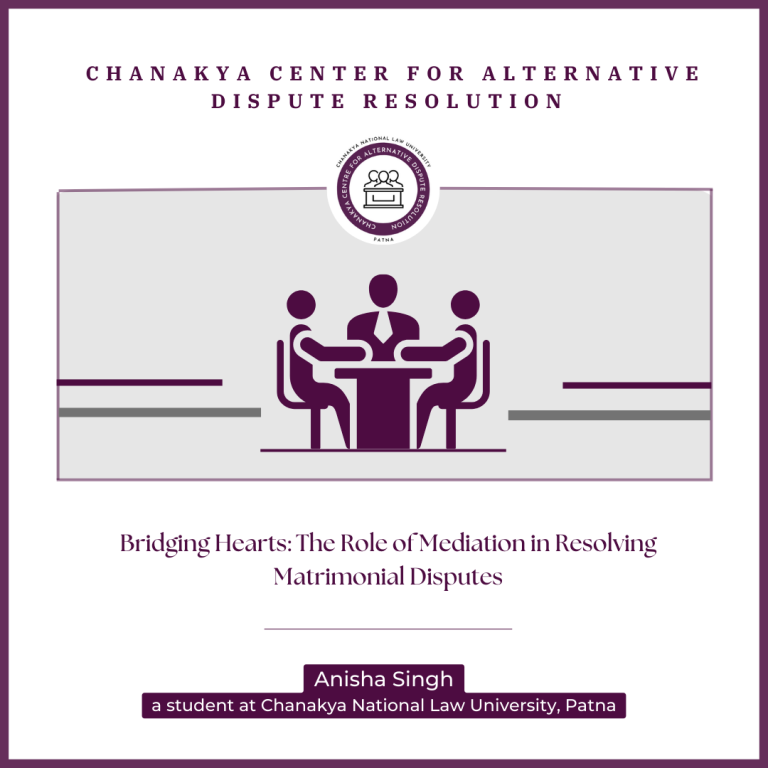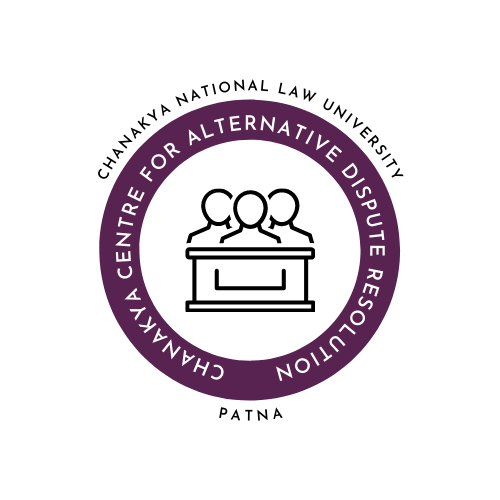
Table of Contents
This article has been authored by Anisha Singh, a student at Chanakya National Law University , Patna.
Introduction
“An ounce of mediation is worth a pound of arbitration and a ton of litigation”.
Joseph Grynbaum
Marriage is both a social event and a legal obligation, representing a stable, long-term partnership where two individuals support each other. However, when a marriage breaks down, various relationships have to be adjusted, which disrupts the family’s usual structure and peace. The changing social structure in India, where increasing literacy and financial independence among couples have led to a rise in marital conflicts as modern marriages become more open to the idea of divorce, traditional methods of resolving disputes no longer meet the needs of those involved. According to a report presented by the United Nations, divorce rates in India have increased twofold since the advent of the millennium. These disputes often involve complex emotional, social and personal issues, unlike other contractual disputes. This makes mediation essential as it fosters dialogue and encourages empathy & understanding between the disputing parties.
Mediators: Architects of Harmony in Matrimonial Disputes
In earlier times, family disputes were often resolved through collective discussions or referred to village panchayats. Today, mediation has become the preferred method for settling matrimonial disputes. However, there exist two ideologies. Advocates of mediation highlight its ability to preserve family relationships, sparing children the trauma of traditional courtroom battles. The critics, on the other hand, argue it lets wrongdoers off the hook without proper punishment. Nevertheless, mediation plays a pivotal role in maintaining social harmony.
India follows an adversarial legal system, and lately, the judiciary’s role has widened significantly. This widened role has led to increased costs and significant delays in providing justice. Although there has been a rise in the number of courts in the last few years, the issue still persists due to a corresponding increase in the number of cases. In such situations, alternative dispute resolution methods, such as mediation, offer a solution by resolving disputes outside of court in a more timely and cost-effective manner. These methods underscore the significance of Article 21, which guarantees the right to life and includes the right to a speedy trial.
Mediation is a voluntary, binding process in which an impartial and neutral intermediary (mediator) facilitates negotiation between the conflicting parties and assists them to settle it by understanding each other’s point of view. It can lead to amicable separations or reconciliations, avoiding the adversarial nature of litigation. Mediation also preserves confidentiality and reduces conflict volatility. During mediation, parties can either agree to separate amicably or reconcile. If they reconcile, any ongoing lawsuit must be dismissed, typically in the High Court. Mediation allows minor issues in matrimonial disputes to be easily resolved, ensuring no one loses.
A new concept under mediation called Pre-litigation mediation allows parties to settle disputes before legal action. However, the Mediation Act, 2023, doesn’t provide compulsory mediation at the pre-litigation stage, as the proceedings may involve rights in rem. But there are many advantages of choosing mediation over litigation. In mediation, the mediator’s sole purpose would be to restore the status quo, resolve the dispute amicably while being unbiased and remain non-judgmental throughout. Even the costs are less because normally the settlement is faster. It avoids trial uncertainties and preserves confidentiality.
In the case of Moti Ram (D) Tr. LRs. & Anr. Vs. Ashok Kumar & Anr., the confidentiality of mediation proceedings was emphasised by the Supreme Court. It stated that the mediation sessions are private, and mediators should not disclose details of the discussions. If mediation succeeds, the mediator submits the agreement without disclosing the details of the session; if it fails, they simply report its failure. This is how the confidentiality of the mediation process is maintained. Courts should use their inherent powers under Section 528 of the BNSS to expedite matrimonial disputes, particularly when the parties are seeking reconciliation, as this section allows courts to quash proceedings where needed to ensure justice and prevent misuse of court processes.
Empowering families: Legislation promoting Mediation in India
In the milestone judgment of “Salem Advocate Bar Association, Tamil Nadu v. Union of India”, the Apex Court emphasised strict adherence to ADR provisions, including mediation, as recommended by its appointed committee. The rise of mediation should focus on earning the confidence and respect of litigants.
Section 5 of the Family Courts Act of 1984 allows courts to refer family conflicts to mediation through social welfare organisations. Section 6 mandates appointing permanent counsellors to facilitate and encourage family settlements. Additionally, Section 9 of the Family Courts Act of 1984, along with Section 89 and Order XXXII-A of the Civil Procedure Code of 1908, requires courts to render an opportunity for proposed resolutions before moving to adjudication. Section 23 of the Hindu Marriage Act of 1955 emphasises the judge’s responsibility to strive for reconciliation, according to the nature and circumstances of the case. Similar provisions in Sections 34(3) and 34(4) of the Special Marriage Act of 1954 mandate that courts prioritise reconciliation when parties file for divorce.
Mandatory mediation was introduced in 2003, allowing courts to refer cases without both parties’ consent to preserve family relationships, especially in matrimonial disputes. Therefore, the matrimonial cases are covered under the ambit of mandatory mediation as family relationships need to be preserved. In a landmark judgment of B.S. Joshi & Others vs. State of Haryana & Another, the wife withdrew an FIR against her partner, citing reconciliation and hasty filing. The Apex Court emphasised that the courts should “promote reconciliation in such matrimonial disputes”.
The Law Commission of India’s 10th report stresses a different approach for family disputes, advocating for mediation before trial. Moreover, it is legally required to settle such disputes speedily and equitably for the litigants, and it is highly advocated that marriage and divorce cases should be dealt with separately. In the case of Manas Acharya vs. State & Another, it was affirmed that the mediation resolutions should be treated as legally binding, and the emphasis should be on the importance of decisions made during mediation.
Beyond conflict: Harnessing mediation for domestic violence cases
Domestic violence is among the cases often addressed by mediators. There is a growing recognition of the importance of mediating such cases before taking them to court. Sometimes, the parties involved may not even realise that their actions are violent, viewing them as normal behaviour within the relationship. They may choose not to reveal these issues, but it is the duty of the mediator to carefully pay attention to every detail of both parties, and ask the right questions that can uncover the truth. Mediators are skilled at reading between the lines and identifying acts of domestic violence in such cases.
According to NCRB data in 2018, housewives comprised the second-largest segment of suicidal deaths in India. One of the reasons is Domestic abuse that comes under the ambit of Section 498A of the Indian Penal Code, which is non-compoundable in nature, but courts have embraced mediation for resolving marital issues.
In the case of Mohd. Mushtaq Ahmad v. State before the Karnataka High Court, conflicts between the couple surfaced following the birth of their daughter. The wife initiated a divorce petition and lodged an FIR against the husband under Section 498A of the IPC. The High Court, invoking Section 89 of the Civil Procedure Code, directed the parties to attempt mediation.
The Karnataka High Court allowed the wife’s petition and quashed the criminal proceedings under Section 498A IPC and Sections 3 and 4 of the Dowry Prohibition Act, 1961, concluding that doing so was necessary to meet the ends of justice.
.The court aims to resolve disputes as amicably as possible, aligning with the principles of mediation, which focus on preserving family relationships and delivering swift justice.
The establishment of Mahila Adalats has further enhanced the handling of matrimonial conflicts by providing a more efficient approach. These courts strive to create a safe and non-intimidating space for women to address domestic issues, addressing the historically low rate at which women have sought help from state mechanisms. Mahila Adalats consist of both quasi-judicial and non-judicial bodies that enable women to voice their concerns. Their unique structure includes all-women mediators and mediators who share the same class, social, or cultural background as the parties involved.
Conclusion
Mediation in family and matrimonial disputes is transformative, providing hope and compassion amid emotional conflict. Indian laws prioritise safeguarding marriage, thus making it mandatory for courts to attempt reunion and settlement between the parties. Mediators do not determine what is right or just; rather, they act as synergists, bridging opposing interests by defining issues and removing communication barriers. Therefore, it’s concluded that mediation is advantageous if enforced with a robust body of mediators who are properly trained to identify suitable cases for mediation. Moreover, the establishment of pre-litigation clinics can raise awareness and promote peaceful dispute resolution.
